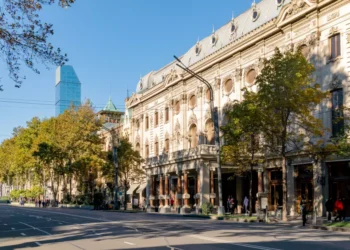Every May in Georgia, the streets swell with teenagers in white button-downs streaked with neon scribbles, illustrated declarations of love, pop culture references, spiritual totems, and absurdist graffiti. It looks chaotic. It is joyful. But beneath the color, there’s a deeper story to be told — about ritual, identity, and post-Soviet reinvention. What began in the 1990s as a grassroots tradition among Tbilisi school-leavers has evolved into a meaningful cultural phenomenon, one that merges personal expression with collective memory and local mythology with global fashion currents.
From Uniform to Uniqueness: The Aesthetic Politics of the Graduation Shirt
At its heart, the painted graduation shirt, worn on the day of the bolo zari (“last bell”) — is a rite of passage. The white shirt, once a symbol of uniformity and discipline, becomes a medium of self-expression. Each graduate either decorates their own shirt in advance or invites friends, classmates, and teachers to leave inscriptions, signatures, and drawings directly on their back.
The tradition, according to oral histories, emerged organically in Tbilisi sometime in the mid-1990s — a period marked by the collapse of Soviet structures and a sudden need for new rituals to replace the discarded ones. Just as many post-Soviet cultures saw a reinvention of weddings, funerals, and memorials, Georgian youth sought out new forms to mark the psychological crossing into adulthood. The defaced shirt, filled with coded messages, inside jokes, and stylized illustrations, became that threshold.
Cultural anthropologist Victor Turner describes rites of passage as containing three phases: separation, liminality, and incorporation. The graduation shirt ritual fits perfectly within this framework. First, students dress identically in white — a nod to their shared status. Then they allow that blank slate to be deconstructed through drawing and writing — a liminal act of symbolic transformation. Finally, the shirt becomes a personal artifact: preserved, folded away, remembered.
Ink, Memory, and Performance: The Shirt as a Social Object
These shirts are not just souvenirs. They are mnemonic objects — vessels of memory, charged with emotion and collective significance. As scholars like Pierre Nora have argued, modern societies increasingly invest memory into objects and places once traditional oral or ritual structures fade. In a country where Soviet-era commemorative rituals were often rigid and top-down, this spontaneous youth-created tradition offers an alternative memory-keeping practice.
Crucially, the inscriptions on the shirts are often ephemeral, humorous, flirtatious, sometimes even transgressive. Messages like “First time I’ve seen you all year” or “To my invisible crush” play with social conventions, teasing out hidden dynamics within the classroom. Others are sincere: dedications from teachers, confessions of love, or simply dates and names. These shirts become a wearable archive of social relationships.
In recent years, an informal micro-industry has grown around the tradition. Young artists, many of them former graduates themselves, offer to create custom illustrations on commission. These are not mass-produced items, but handcrafted works, echoing the rise of DIY and personalized culture in Georgia’s youth scene. Even when digital print-on-demand services began to offer “pre-made” graduation shirt designs, many students rejected them in favor of one-of-a-kind, hand-painted pieces. The tradition remains, at its core, about intimacy.
High Fashion and Street Sentimentality: From Schoolyard to Runway
In 2018, the painted graduation shirt entered the global fashion circuit. Georgian designer Demna Gvasalia, creative director of Balenciaga and founder of Vetements, released a shirt in the Spring/Summer 2019 collection directly referencing this Georgian ritual. The garment — a crisp white button-up with scribbled drawings and personal messages screen-printed on it — was sold for over $1000. The messages read like notes from classmates: “Congrats, my boy,” “In case you forget me,” “I was here.”
Critics in the West viewed it as another example of Gvasalia’s post-ironic streetwear, part of a broader tendency in contemporary fashion to blur the lines between authenticity and simulation. But for those familiar with Georgian cultural codes, it was a loaded gesture. Gvasalia wasn’t merely appropriating a subcultural aesthetic — he was exporting an emotional artifact from his own coming-of-age experience in the post-Soviet periphery. The runway, in this case, became a space of diasporic nostalgia.
This gesture also re-inscribed the shirt-signing tradition into a broader conversation about global youth culture and commodification. Can something as intimate as a farewell shirt be turned into a luxury item? What happens when a local memory ritual becomes a fashion trend?
Rituals of Selfhood in Transitional Societies
Anthropologist Alexei Yurchak, in ‘Everything Was Forever, Until It Was No More,’ describes the strange temporality of late Soviet and post-Soviet youth, caught between the collapse of one ideological system and the emergence of another. The graduation shirt ritual belongs to this in-between space. It does not inherit from the Soviet ceremonial mold, nor does it mimic Western graduation culture with caps and gowns. Instead, it grows sideways: an improvised hybrid of performance, friendship, and rebellion.
Unlike the rigid ceremony of most Western high school graduations — where students wear identical robes, march in formation, and receive diplomas from behind podiums — the Georgian version is more carnivalesque. Friends chase each other with markers. Shirts are painted with dragons, hearts, sports logos, and sacred mountains. Some students add quotes from Nika Turbina, Freddie Mercury, or Guram Dochanashvili. Others draw icons of Tbilisi’s neighborhoods, graffiti tags, or symbols of protest. It’s a youth ritual that makes space for both the deeply personal and the socially resonant.
In a society still negotiating its relationship with post-Soviet identity, national heritage, and global modernity, the act of painting your own clothes becomes an act of authorship — a small but defiant way of saying, this is who I was when I left childhood behind.
The Shirt that Carries a Life
In the years after graduation, these shirts are rarely worn again. But they are kept. Folded in wardrobes. Packed in storage. Hung like relics. They function like keepsake boxes or time capsules. In some families, a graduation shirt might be brought out years later at a wedding or during a move. It is, in many ways, a secular amulet, infused with emotion, names, jokes, and smells of that last school summer.
In the 2020s, amid rising digitization and surveillance, such analog rituals carry a renewed power. The hand-painted shirt resists the algorithm. It cannot be copied, reposted, or deleted. It is non-transferable. It remembers not as a database, but as a garment worn close to the skin.
A Shirt for a Nation in Transition
The Georgian graduation shirt ritual is deceptively simple — a marker, a white blouse, a gathering of friends. But in its folds lie the textures of a society in flux: post-Soviet improvisation, youthful authorship, community aesthetics, and intimate resistance to commodified memory.
It is a tradition made from laughter and loss, from kitsch and meaning, from ink and cotton. And in a world that increasingly tells young people they are replaceable, forgettable, and always online, it offers something quietly radical: the right to be remembered — personally, imperfectly, and in your own handwriting.
By Ivan Nechaev














